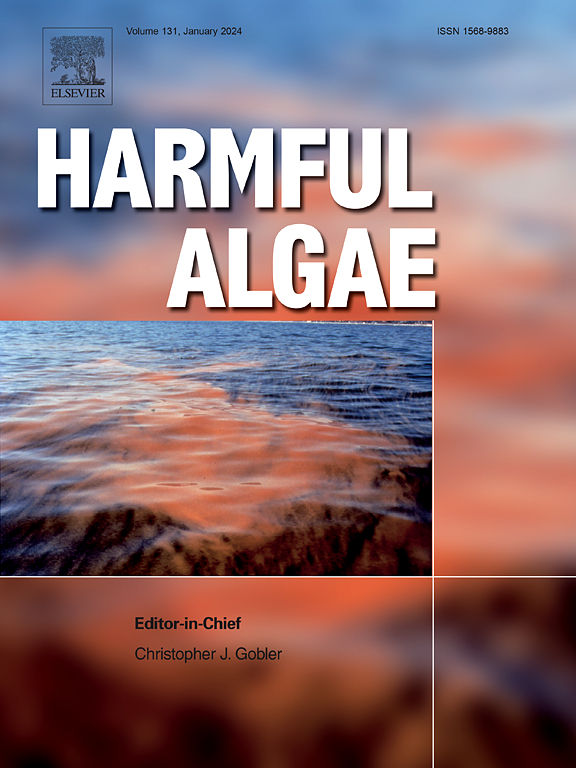Differentiation of microbial communities in coastal seawater before and during an Akashiwo sanguinea (Dinophyceae) bloom in the urban area of Antofagasta city (northern Chile)
IF 5.5
1区 生物学
Q1 MARINE & FRESHWATER BIOLOGY
引用次数: 0
Abstract
Harmful algal blooms (HABs) are highly relevant for public health, the economy, the ecosystem, and biodiversity stability in southern Chile (40° to 53°S), where they occur regularly and are frequently monitored. However, HAB events and their associated microbes in northern Chile (17° to 30°S) remain unknown and difficult to track due to a lack of monitoring, particularly in urban areas. We investigated changes in microbial communities in coastal seawater before and during an Akashiwo sanguinea bloom (B) at two sampling points in Antofagasta city (23°38′39S, 70°24′39W). Seawater samples (filtered at 1 and 0.2 μm) were collected during distinct bloom phases (control, prebloom, and in-bloom), and 16S and 18S rDNA gene libraries were constructed and analyzed via the DNA metabarcoding technique. Our findings indicate that species diversity within the 16S rDNA-based community was greater during the prebloom phase than during the control and in-bloom phases. Conversely, species diversity within the 18S rDNA-based community was lower during the in-bloom phase than during the control and prebloom phases. Independent of the sampling points and fractions, principal coordinate analysis (PCoA) revealed distinct differences in both the 16S and 18S rDNA-based communities between the analyzed bloom phases. Our analysis further revealed that the 16S rDNA-based community was dominated by the Flavobacteriaceae and Rhodobacteraceae families, whose abundance decreased and increased, respectively, during the bloom. As anticipated, the structure of the 18S rDNA-based community was predominantly governed by the Gymnodiniaceae family, specifically the Akashiwo genus, during the bloom. The differentiation in microbial communities was more pronounced in taxa with low abundances than in the dominant taxa. Additionally, co-occurrence network analysis revealed predominantly positive relationships within the microbial communities, particularly during the bloom event. Our analysis also identified several bacterial genera as keystone taxa within the microbial communities, notably members of Pseudomonadota and Bacteroidota.
智利北部安托法加斯塔市区赤潮发生前和发生期间沿海海水中微生物群落的分化
有害藻华(HABs)与智利南部(南纬40°至53°)的公共卫生、经济、生态系统和生物多样性稳定高度相关,在那里它们定期发生并经常受到监测。然而,由于缺乏监测,特别是在城市地区,智利北部(南纬17°至30°)的赤潮事件及其相关微生物仍然未知,难以追踪。在安托法加斯塔市(23°38′39S, 70°24′39W)的两个采样点,研究了赤潮发生前和发生期间沿海海水中微生物群落的变化。在不同的水华阶段(对照、水华前和水华中)采集海水样品(过滤温度为1 μm和0.2 μm),构建16S和18S rDNA基因文库,并通过DNA元条形码技术进行分析。结果表明,以16S rdna为基础的群落在开花前阶段的物种多样性高于对照期和开花期。相反,以18S rdna为基础的群落在花期的物种多样性低于对照和花期。主坐标分析(principal coordinate analysis, PCoA)结果显示,与采样点和分数无关的16S和18S rdna群落在不同开花期存在显著差异。结果表明,以16S rdna为基础的群落以黄杆菌科(Flavobacteriaceae)和红杆菌科(Rhodobacteraceae)为主,其丰度在开花期间分别呈下降和上升趋势。正如预期的那样,在开花期间,以18S rdna为基础的群落结构主要由Gymnodiniaceae家族,特别是Akashiwo属控制。微生物群落的分化在低丰度分类群中比在优势分类群中更为明显。此外,共现网络分析揭示了微生物群落之间的主要正相关关系,特别是在水华事件期间。我们的分析还确定了几个细菌属作为微生物群落的关键分类群,特别是假单胞菌门和拟杆菌门。
本文章由计算机程序翻译,如有差异,请以英文原文为准。
求助全文
约1分钟内获得全文
求助全文
来源期刊

Harmful Algae
生物-海洋与淡水生物学
CiteScore
12.50
自引率
15.20%
发文量
122
审稿时长
7.5 months
期刊介绍:
This journal provides a forum to promote knowledge of harmful microalgae and macroalgae, including cyanobacteria, as well as monitoring, management and control of these organisms.
 求助内容:
求助内容: 应助结果提醒方式:
应助结果提醒方式:


